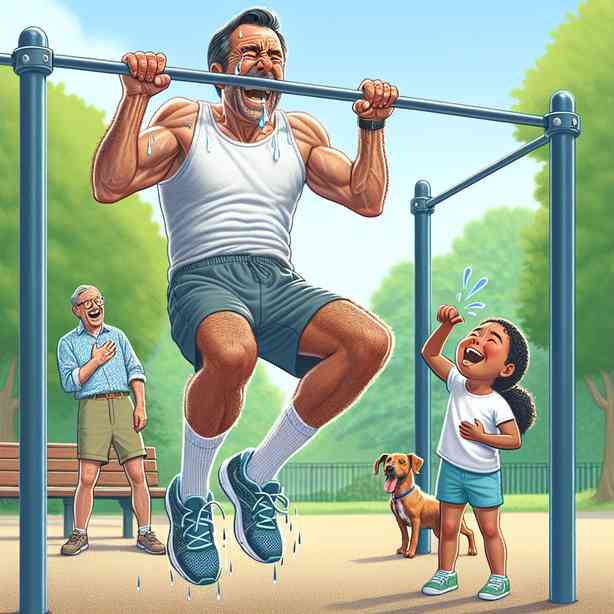
Pull-ups are often heralded as one of the ultimate tests of upper body strength. They are an impressive display of power and endurance that not only requires physical strength but also mental resilience. However, many people find themselves struggling when they first attempt to perform this exercise. Today, we will delve into the journey of attempting pull-ups for the first time, discussing why it can be so challenging, the importance of proper technique, and how to effectively build the strength necessary to master this exercise.
When you approach a pull-up bar for the first time, a mix of excitement and trepidation might wash over you. This is normal. It’s essential to recognize that pull-ups engage several major muscle groups, including the latissimus dorsi, biceps, and shoulders, along with the core for stability. As you grip the bar, you might notice how your body prepares itself for what’s to come, signaling the start of a struggle against gravity. However, when you actually attempt your first pull-up, it can be humbling. Your body may feel heavy, and you may find that your arms can only pull you up a short distance before you come to a halt.
This experience can be disheartening. You may question your strength or fitness level, but it is important to keep in mind that many people, regardless of their fitness background or level, struggle with pull-ups initially. The reality is that this exercise requires a significant amount of upper body strength that can’t be built overnight. Pull-ups also demand coordination and proper technique, which can take time to develop. Accepting this fact allows you to approach the learning process with a more positive mindset.
Technique plays a crucial role in your ability to successfully perform a pull-up. When attempting your first pull-up, make sure that you are using the correct grip. Your hands should be slightly wider than shoulder-width apart on the bar, and your palms should face away from you. Engaging your shoulder blades by “pulling” them down and back before initiating the movement will help stabilize your shoulders and provide a more effective starting point. The movement itself should begin with your elbows driving downwards rather than pulling with your arms alone. This shift in focus can help you maximize your strength and efficiency during the pull-up.
If you’ve attempted pull-ups and found success elusive, don’t be discouraged. This is a common experience, and it can be helpful to employ a variety of strategies to build the necessary strength. One effective method is to incorporate assisted pull-up exercises into your routine. These can include using resistance bands, which can help offload some of your body weight, making the movement easier.
Another approach involves working on strength-building exercises for the major muscles involved. Exercises such as lat pull-downs, inverted rows, and rowing movements using various equipment can enhance your overall upper body strength. Additionally, developing your core strength through planks and hollow body holds will provide you with the stability needed to perform pull-ups effectively.
As you progress in your strength development, it’s vital to track your improvements. Celebrate the small victories along the way, whether that’s holding onto the bar longer, performing partial pull-ups, or simply feeling stronger in related exercises. Keeping a training journal can serve as motivation by visualizing your progress over time. You may start by aiming for multiple sets of negatives, which involve jumping or using assistance to get to the top position and then slowly lowering yourself. This eccentric component builds strength and control.
In the early stages of your training, patience is key. It may take weeks or even months of consistent practice before you can complete a full pull-up. During this journey, maintaining an open mind and nurturing a growth mindset can significantly influence your success. Understand that setbacks may occur—perhaps a day when you feel weaker or when your progress plateaus—but this is entirely normal. Each attempted pull-up is a step on the path to mastering the movement.
Moreover, you don’t have to embark on this journey alone. Joining a fitness class or finding a workout partner can enhance your motivation and accountability. Engaging with others who are also working towards pull-up mastery creates a supportive environment, making the experience enjoyable and less intimidating. Sharing tips, experiences, and setbacks with others can also provide valuable insights that enrich your training.
Ultimately, the story of “the day you tried pull-ups (and failed)” is just one chapter in your fitness journey. The initial failure is not the endpoint but rather a stepping stone toward your goals. Each time you step up to the bar, you are cultivating resilience, strength, and character—qualities that extend far beyond the gym. Embrace your unique journey; every individual progresses at their own pace, and with dedicated effort and perseverance, you will triumph over the challenge of pull-ups.
The key takeaway is to remain committed to your training and embrace the adventure of learning. With consistent practice, a focus on proper technique, and supplementary exercises, you will work your way up to confidently completing your first pull-up. Remember, the mental aspect is just as critical as the physical. Cultivate a positive attitude and remain patient with yourself as you navigate this challenging yet rewarding journey.
Eventually, the day will come when you not only succeed in performing your first pull-up but also begin to see it as just one of many incredible achievements on your fitness path. Every struggle, every moment of uncertainty, and every drop of sweat will have been worth it. Each attempt brings you closer to transforming the initial disappointment into empowerment and accomplishment. So, the next time you approach that pull-up bar, you will do so not with fear but with anticipation, knowing you are ready to take on the challenge. After all, it is not just about the pull-up itself but the journey you embark upon to get there. Embrace it, and enjoy the growth it brings, both physically and mentally.


